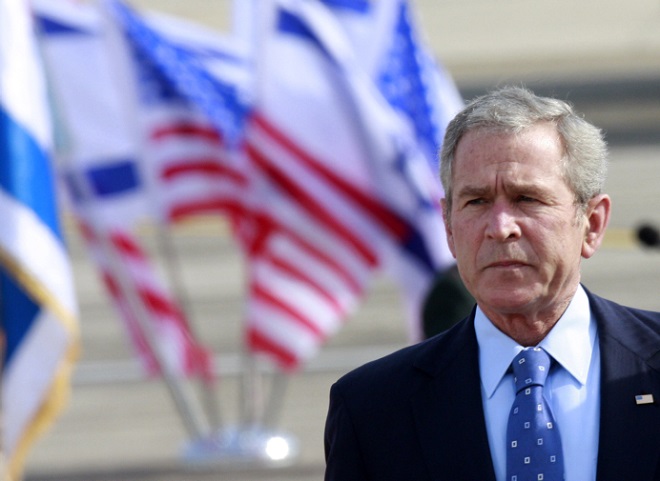Michael Oren's political plan is based on a diplomatic promissory note which has long since been disavowed, and never meant what he thought it meant.
Israel's former ambassador to the United States and American Jewish celebrity promises American support for his political plan, but it's a check he can't cash · How an experienced historian reads far too much into a diplomatic document which doesn't promise what he claims it does

Some of the fog surrounding Moshe Kahlon's new party is being lifted. Dr. Michael Oren, former Israeli ambassador to the United States and the "foreign affairs" representative in Kahlon's party, recently laid out his diplomatic program at the popular Hebrew news site Walla. The article gives us a chance to go down memory lane and discuss one of the most discussed diplomatic letters between statesmen at the time – then-President Bush's letter to then-Prime Minister Sharon in 2004.
Oren writes:
A decade ago, in April 2004, then-Prime Minister Ariel Sharon received a letter from American president George Bush, Jr. recognizing Israel's right to build in long-standing Jewish neighborhoods in Jerusalem like Talpiyot-East and Ramot. Furthermore, Israel was now allowed to build in settlement blocs crucial for Israel's security, and in which some 80% of Israelis who live in Judea and Samaria reside […] According to the Bush-Sharon letter, these areas will remain within Israel's borders in any arrangement arrived at with the Palestinians […] it's time to revive the Bush-Sharon letter and act according to it.
Plausible Deniability
In 2004, in response to a letter from Sharon describing the outlines of the Disengagement Plan from Gaza, the President responded with a letter of thanks, which included a presidential declaration which can be interpreted in more ways than one.
The attempts of the Israeli media to decode the letter led to serious political and diplomatic crises, as well as increased suspicion and mutual distrust on both sides of the Atlantic. To make a long story short, the ultimate conclusion was that there is no guarantee that Oren really understood what the letter signified or how solid a promise it actually was. Oren's political plan is thus based not on solid diplomatic ground, but on self-deception and wishful thinking.
Here's the text of the letter in question:
As part of a final peace settlement, Israel must have secure and recognized borders, which should emerge from negotiations between the parties in accordance with UNSC Resolutions 242 and 338. In light of new realities on the ground, including already existing major Israeli populations centers, it is unrealistic to expect that the outcome of final status negotiations will be a full and complete return to the armistice lines of 1949, and all previous efforts to negotiate a two-state solution have reached the same conclusion. It is realistic to expect that any final status agreement will only be achieved on the basis of mutually agreed changes that reflect these realities.
Oren has decided to take an expansive view of this paragraph, according to which the aforementioned "major population centers" include what Israelis know as the "blocs": the Ariel bloc, Maaleh Edumim and the Etzion Bloc. But Oren also adds something which is not mentioned at all in the letter as well, namely "to build in settlement blocs crucial for Israel's security, and in which some 80% of Israelis who live in Judea and Samaria reside."

An Unlikely Interpretation
Aside from the fact that construction rights are not mentioned in the letter at all, Israel has never managed to get a firm statement that the "major population centers" are indeed the aforementioned blocs. A year following the letter's publication, Israeli diplomatic reporters tried to breach the American wall of opacity and figure out, once and for all, what Bush meant. Was he referring to the large settlement blocs or did he mean Jewish neighborhoods in Jerusalem which were built over the Green Line such as Ramot, Gilo, Neve Yaakov and Armon Hanetziv?
Later a clear American indication came disavowing the former possibility: then American ambassador Dan Kurtzer stated in a closed lecture that the United States does not agree that the Separation Barrier then under construction should include the large settlement blocs. Yediot Aharonot's diplomatic reporter, Shimon Shiffer, revealed this statement and explained what it unequivocally meant. On the assumption that the Separation Barrier will represent the new border, Shiffer came out with a prominent headline that Israel and the US don't even agree on the fate of the settlement blocs.
Knowing that his article would make waves and hurt Sharon – the Disengagement Plan itself was on the line – Shiffer hoped that the Americans would be backed against the wall, and confirm their support for the retention of the Ariel, Maaleh Edumim and Etzion blocs to ensure the Disengagement is carried out and not stopped by an internal political move against Sharon.
Everything went according to plan – except the last part. The Sharon government almost fell, the Bush administration was attacked by Congress, but a clear announcement by the Bush Administration on the settlement blocs never materialized. The American objection to enclosing the blocs in the Separation Barrier remains, and the letter itself has since been effectively disavowed by the Obama administration.
Oren may claim that there were oral understandings and that both Israeli and American diplomats agree to this idea. But as someone who knows about how America suddenly "forgot" its commitment to ensure Israeli shipping through the Straits of Tiran in the 1967 crisis, perhaps Oren would be wise to be just a bit more skeptical.
Hanan Amiur is an analyst at the media watchdog website Presspectiva.
English translation by Avi Woolf.
To receive updates on new articles in English, join Mida on Facebook or Twitter or join our mailing list.






we have a moral right to interpret the Bush letter of 2004 as Michael Oren does. The plain meaning of the words is what Oren reads and no doubt was meant by Bush to mean. But the problem is that the letter was not specific about naming the "major Israeli population centers." Therefore, the problem is the same one that Golda Meir identified 45 years ago: Who will guarantee the guarantee?
In other words, promises by the US or other Western powers or international are not dependable. Moreover, Israel cannot simply decide to set its own borders and expect the essentially hostile "friendly" powers like the US to go along and agree. Oren sounds awfully naïve.l